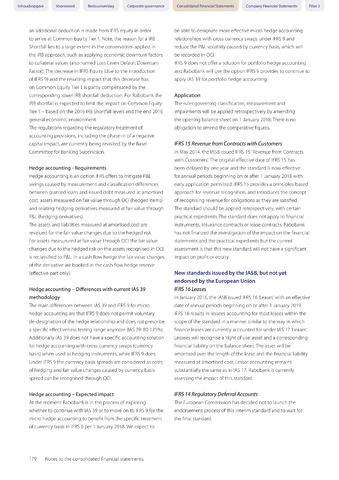Inhoudsopgave Voorwoord Bestuursverslag Corporate governance
Consolidated Financial Statements Company Financial Statements Pillar 3
an additional deduction is made from IFRS equity in order
to arrive at Common Equity Tier 1Note, the reason for a IRB
Shortfall lies to a large extent in the conservatism applied in
the IRB approach, such as applying economic downturn factors
to collateral values (also named Loss Given Default Downturn
Factor).The decrease in IFRS Equity (due to the introduction
of IFRS 9) and the resulting impact that this decrease has
on Common Equity Tier 1 is partly compensated by the
corresponding lower IRB shortfall deduction. For Rabobank the
IRB shortfall is expected to limit the impact on Common Equity
Tier 1 - based on the 2016 IRB Shortfall levels and the end 2016
general economic environment.
The regulations regarding the regulatory treatment of
accounting provisions, including the phase-in of a negative
capital impact, are currently being revisited by the Basel
Committee for Banking Supervision.
Hedge accounting - Requirements
Hedge accounting is an option IFRS offers to mitigate P&L
swings caused by measurement and classification differences
between granted loans and issued debt measured at amortised
cost, assets measured on fair value through OCI (hedged items)
and relating hedging derivatives measured at fair value through
P&L (hedging derivatives).
The assets and liabilities measured at amortised cost are
revalued for the fair value changes due to the hedged risk.
For assets measurured at fair value through OCI the fair value
changes due to the hedged risk on the assets recognised in OCI
is reclassified to P&L. In a cash flow hedge the fair value changes
of the derivative are booked in the cash flow hedge reserve
(effective part only).
Hedge accounting - Differences with current IAS 39
methodology
The main differences between IAS 39 and IFRS 9 for micro
hedge accounting are that IFRS 9 does not permit voluntary
de-designation of the hedge relationship and does not prescribe
a specific effectiveness testing range anymore (IAS 39: 80-125%).
Additionally IAS 39 does not have a specific accounting solution
for hedge accounting with cross-currency swaps (currency
basis) when used as hedging instruments, while IFRS 9 does.
Under IFRS 9 the currency basis spreads are considered as costs
of hedging and fair value changes caused by currency basis
spread can be recognised through OCI.
Hedge accounting - Expected impact
At the moment Rabobank is in the process of exploring
whether to continue with IAS 39 or to move on to IFRS 9 for the
micro hedge accounting to benefit from the specific treatment
of currency basis in IFRS 9 per 1 January 2018. We expect to
be able to designate more effective micro hedge accounting
relationships with cross currency swaps under IFRS 9 and
reduce the P&L volatility caused by currency basis, which will
be recorded in OCI.
IFRS 9 does not offer a solution for portfolio hedge accounting
and Rabobank will use the option IFRS 9 provides to continue to
apply IAS 39 for portfolio hedge accounting.
Application
The rules governing classification, measurement and
impairments will be applied retrospectively by amending
the opening balance sheet on 1 January 2018.There is no
obligation to amend the comparative figures.
IFRS 15 Revenue from Contracts with Customers
In May 2014, the IASB issued IFRS 15 'Revenue from Contracts
with Customers'. The original effective date of IFRS 15 has
been delayed by one year and the standard is now effective
for annual periods beginning on or after 1 January 2018 with
early application permitted. IFRS 15 provides a principles-based
approach for revenue recognition, and introduces the concept
of recognising revenue for obligations as they are satisfied.
The standard should be applied retrospectively, with certain
practical expedients.The standard does not apply to financial
instruments, insurance contracts or lease contracts. Rabobank
has not finalized the investigation of the impact on the financial
statements and the practical expedients but the current
assessment is that this new standard will not have a significant
impact on profit or equity.
New standards issued by the IASB, but not yet
endorsed by the European Union
IFRS 7 6 Leases
In January 2016, the IASB issued IFRS 16 'Leases'with an effective
date of annual periods beginning on or after 1 January 2019.
IFRS 16 results in lessees accounting for most leases within the
scope of the standard in a manner similar to the way in which
finance leases are currently accounted for under IAS 17 'Leases'.
Lessees will recognise a 'right of use'asset and a corresponding
financial liability on the balance sheet.The asset will be
amortised over the length of the lease and the financial liability
measured at amortised cost. Lessor accounting remains
substantially the same as in IAS 17. Rabobank is currently
assessing the impact of this standard.
IFRS 14 Regulatory Deferral Accounts
The European Commission has decided not to launch the
endorsement process of this interim standard and to wait for
the final standard.
179 Notes to the consolidated financial statements

